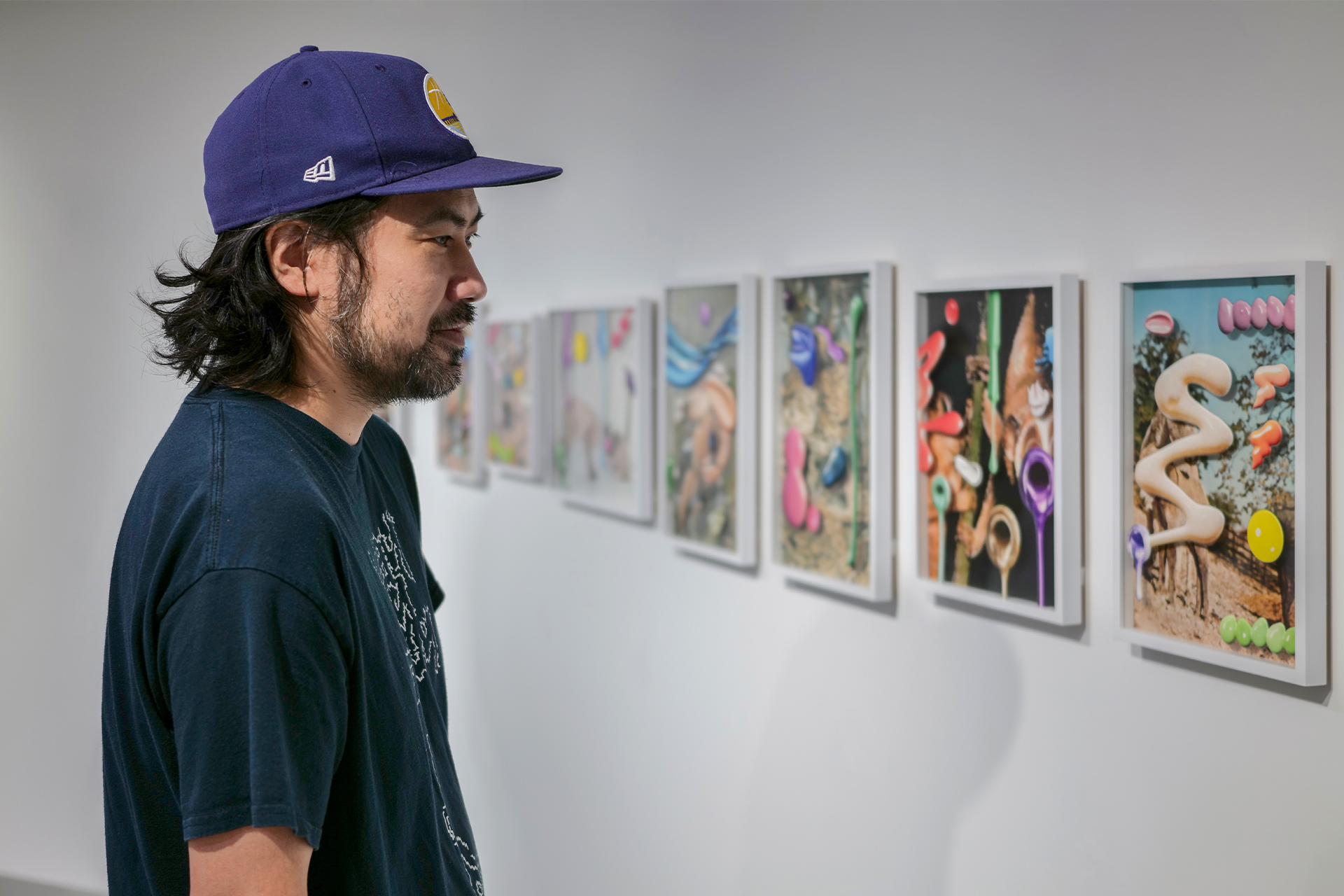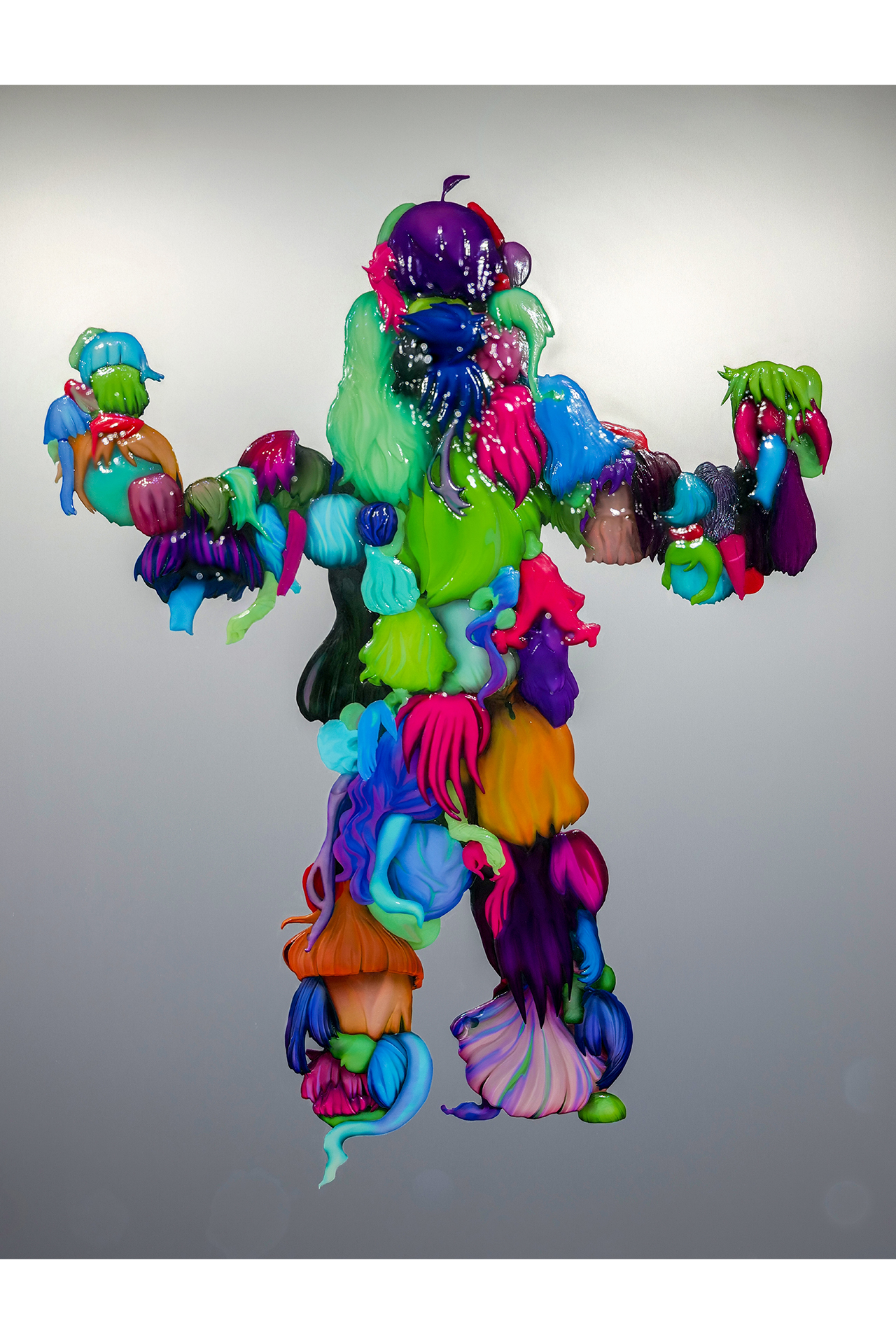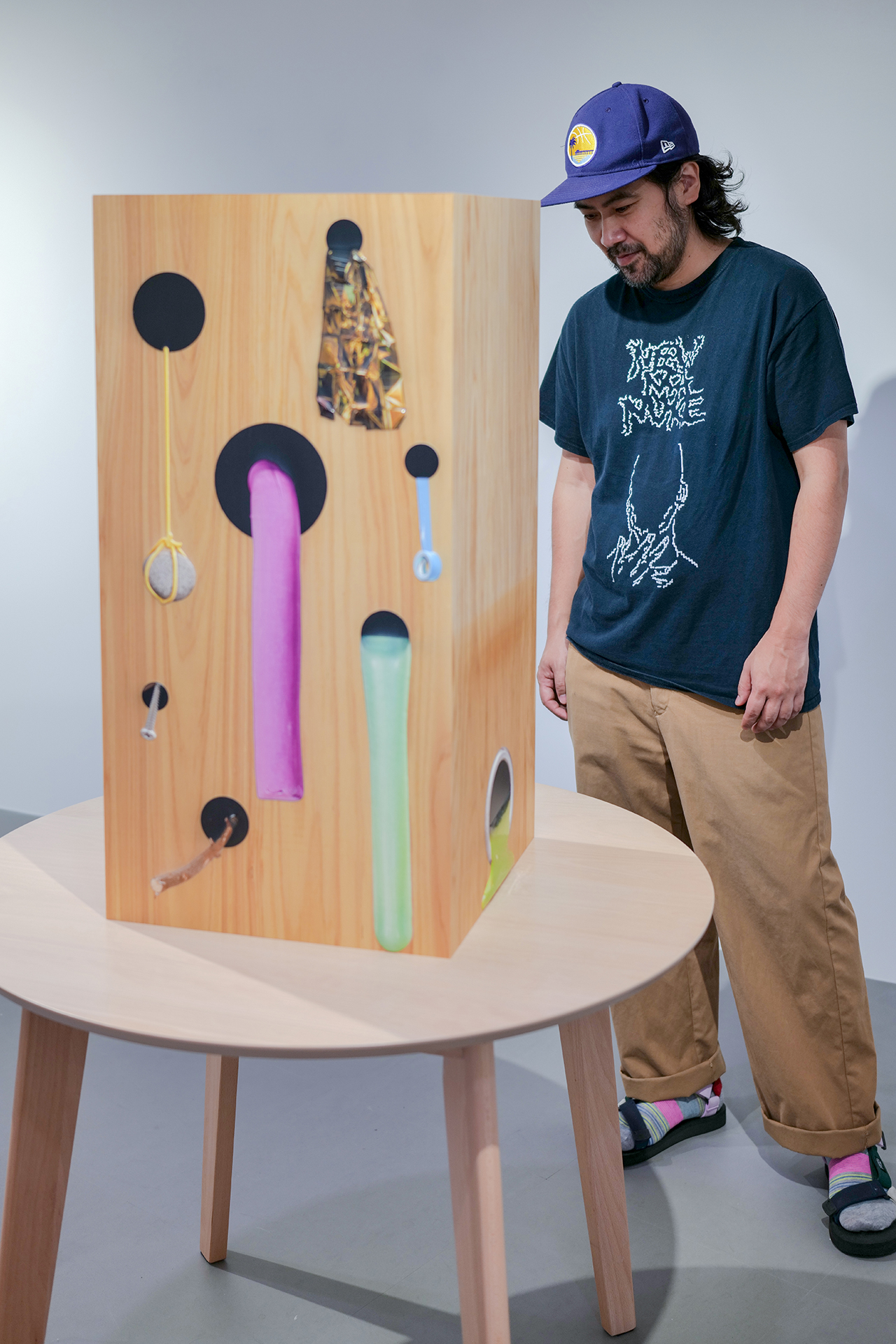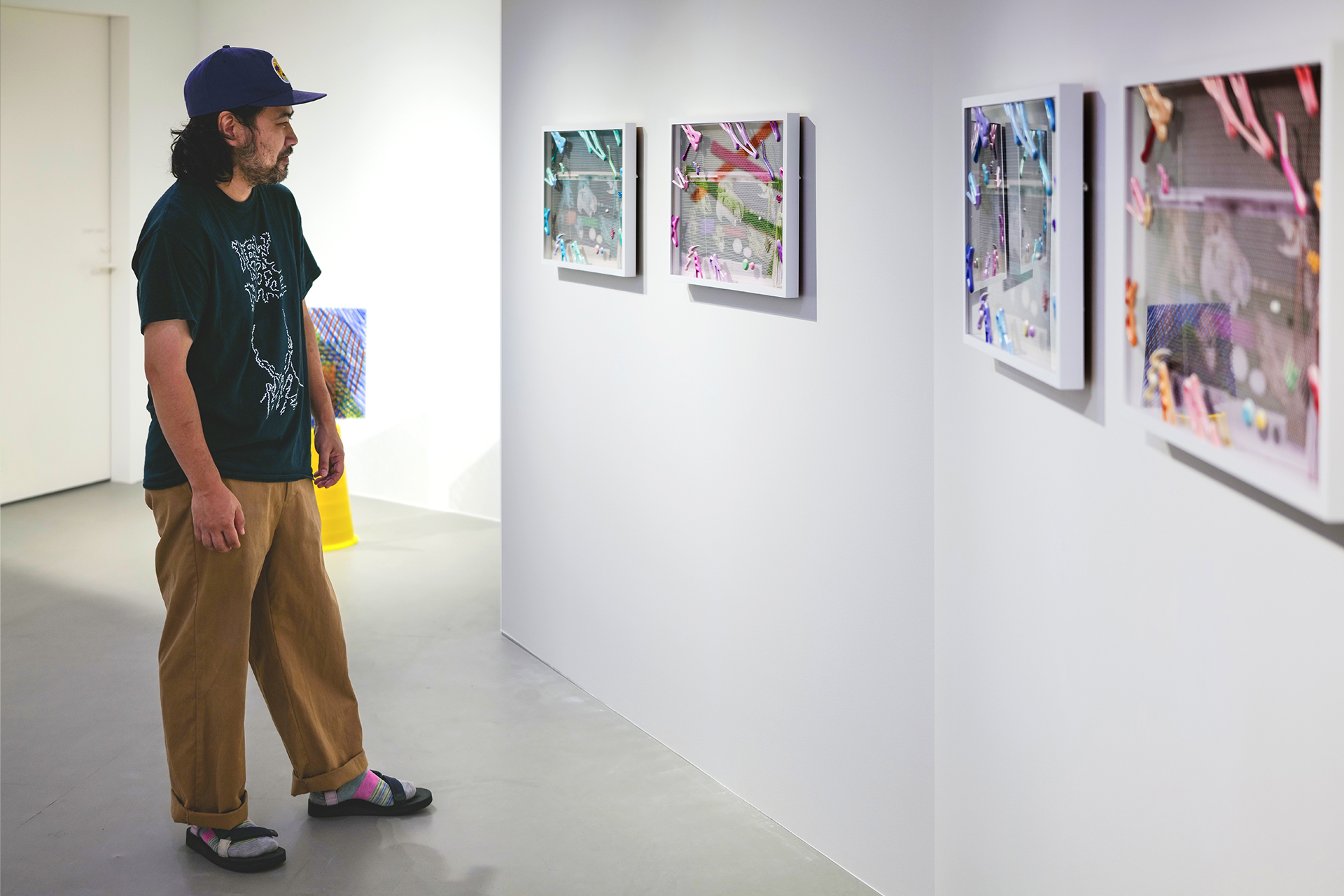REPORT

Teppei Kaneuji is a contemporary artist who has pursued new modes of sculpture. His materials vary from ordinary daily goods, to cut outs from magazines, and figurines. Using a method that could be termed as collage to dismantle and recombine items that evoke the idea of ordinary life, he produces sculpture and installation work. While studying art at university, Kaneuji thought of creating work using daily objects in the same way that artists typically use paints and wood: “Daily goods are things that already hold purpose or meaning in their existence. It was possible to use them as material – not just as an internal challenge in the art but also to relate myself to the world through them and to shift the world itself into medium.”
Teppei Kaneuji is a contemporary artist who has pursued new modes of sculpture. His materials vary from ordinary daily goods, to cut outs from magazines, and figurines. Using a method that could be termed as collage to dismantle and recombine items that evoke the idea of ordinary life, he produces sculpture and installation work. While studying art at university, Kaneuji thought of creating work using daily objects in the same way that artists typically use paints and wood: “Daily goods are things that already hold purpose or meaning in their existence. It was possible to use them as material – not just as an internal challenge in the art but also to relate myself to the world through them and to shift the world itself into medium.”
His most well-known piece is ‘Teenage Fan Club’, a three-dimensional work that uses the hair from different figurines. This object, with the appearance of an unusual creature, was created with the inspiration of the image of an audience at a live concert seen from behind, swaying with the music, and it in interesting from a sculptural standpoint. One of the points that draws attention is the relationship between sculpture and figurines, which are in themselves three-dimensional depictions of two-dimensional characters.

His most well-known piece is ‘Teenage Fan Club’, a three-dimensional work that uses the hair from different figurines. This object, with the appearance of an unusual creature, was created with the inspiration of the image of an audience at a live concert seen from behind, swaying with the music, and it in interesting from a sculptural standpoint. One of the points that draws attention is the relationship between sculpture and figurines, which are in themselves three-dimensional depictions of two-dimensional characters.
In addition, Kaneuji explains that hair is a sculptural motif in itself. “Whether in Greek sculpture or statues of Buddha, hair is very important and difficult to depict. Making ‘Teenage Fan Club’, I wanted to see if I could depict the hair of the audience at a concert moving like some kind of creature, or capture the moment of the situation. Within the piece, the youth culture of music, the idea of sculpture, and the culture of figures are all layered.” be termed as collage to dismantle and recombine items that evoke the idea of ordinary life, he produces sculpture and installation work. While studying art at university, Kaneuji thought of creating work using daily objects in the same way that artists typically use paints and wood: “Daily goods are things that already hold purpose or meaning in their existence. It was possible to use them as material – not just as an internal challenge in the art but also to relate myself to the world through them and to shift the world itself into medium.”

In addition, Kaneuji explains that hair is a sculptural motif in itself. “Whether in Greek sculpture or statues of Buddha, hair is very important and difficult to depict. Making ‘Teenage Fan Club’, I wanted to see if I could depict the hair of the audience at a concert moving like some kind of creature, or capture the moment of the situation. Within the piece, the youth culture of music, the idea of sculpture, and the culture of figures are all layered.” be termed as collage to dismantle and recombine items that evoke the idea of ordinary life, he produces sculpture and installation work. While studying art at university, Kaneuji thought of creating work using daily objects in the same way that artists typically use paints and wood: “Daily goods are things that already hold purpose or meaning in their existence. It was possible to use them as material – not just as an internal challenge in the art but also to relate myself to the world through them and to shift the world itself into medium.”
In recent years, Kaneuji has been producing stage sets and theater plays. Widening the range of his creation, he has garnered high praise from outside the art world. “Going back through the history of art, there are many artists who pursued the technique of collage, and many of them then tried to move into the fields of architecture and theater. It was not only the things on a desk or printed matter that they were dealing with as collage material – they probably wanted to work with the presence of humans and the space they occupy as well. I myself reached that point in the pursuit of my collage, or maybe I should say I ended up there...” said Kaneuji, continuing: “I always want to connect my work to elements that I have no control over, too. If I can control everything then the work is ‘closed’, and not interesting. In that sense, I think plays are a really effective media, because they deal with ‘others’ – something that is fundamentally uncontrollable. At the same time, over the past few years I have been collaborating with people who have different skills and ideas to create work together. This project at RICOH ART GALLERY is one of those collaborations.”
In recent years, Kaneuji has been producing stage sets and theater plays. Widening the range of his creation, he has garnered high praise from outside the art world. “Going back through the history of art, there are many artists who pursued the technique of collage, and many of them then tried to move into the fields of architecture and theater. It was not only the things on a desk or printed matter that they were dealing with as collage material – they probably wanted to work with the presence of humans and the space they occupy as well. I myself reached that point in the pursuit of my collage, or maybe I should say I ended up there...” said Kaneuji, continuing: “I always want to connect my work to elements that I have no control over, too. If I can control everything then the work is ‘closed’, and not interesting. In that sense, I think plays are a really effective media, because they deal with ‘others’ – something that is fundamentally uncontrollable. At the same time, over the past few years I have been collaborating with people who have different skills and ideas to create work together. This project at RICOH ART GALLERY is one of those collaborations.”

This exhibition, which he created in cooperation with StareReap 2.5, the 2.5 dimensional printing technology, consists of four pieces based on previous work, and a three-dimensional piece that is completely new. One of the revisited works is ‘Teenage Fan Club’, made by taking photographs of the existing three-dimensional piece – compressing it into two dimensions, which StareReap 2.5 then added textured expression to. Kaneuji explains, “When 2D characters are forced into 3D they become figures. From that I make them into sculpture, in a chaotic way. Then they are flattened again into 2D, and finally they are finished in 2.5. This gives the work an inexpressible sense of presence.”

This exhibition, which he created in cooperation with StareReap 2.5, the 2.5 dimensional printing technology, consists of four pieces based on previous work, and a three-dimensional piece that is completely new. One of the revisited works is ‘Teenage Fan Club’, made by taking photographs of the existing three-dimensional piece – compressing it into two dimensions, which StareReap 2.5 then added textured expression to. Kaneuji explains, “When 2D characters are forced into 3D they become figures. From that I make them into sculpture, in a chaotic way. Then they are flattened again into 2D, and finally they are finished in 2.5. This gives the work an inexpressible sense of presence.”
‘Sea & Pus’ contains layers of an old picture book of animals that Kaneuji discovered in a skip, along with printed cosmetic textures. In the mysterious ‘tower’, various things enter and exit through a board with a hole. And finally, ‘model of something’ features stripes drawn freehand with color pens on an acrylic board. These new motifs were developed into 2.5 dimensions with the scanned texture of gaffer tape.

‘Sea & Pus’ contains layers of an old picture book of animals that Kaneuji discovered in a skip, along with printed cosmetic textures. In the mysterious ‘tower’, various things enter and exit through a board with a hole. And finally, ‘model of something’ features stripes drawn freehand with color pens on an acrylic board. These new motifs were developed into 2.5 dimensions with the scanned texture of gaffer tape.
The exhibition is entitled ‘S.F.’ – drawn from two words Kaneuji selected: “splash” and “fragments.” He explains that the words were inspired by StareReap 2.5’s “ability to express the material sense of things”, but also hold the connotation of ‘Science Fiction’. “There are two interesting points to StareReap 2.5”, he explains, “One is its accurate reconstruction of printed matter and paint, including their materiality. In other words, it can express with reality, remaining faithful to the original image. At the same time, it can also express the sense of three dimensions in a way that has never existed in printing – and this is not a perfect sense of three dimensions, but rather the strange intermediary of 2.5.” He continues, “It is sort of like fiction. It relates to Sci-Fi in the way that both reality and fiction can coexist within the same expression.” How are these slightly different dimensions used in Kaneuji’s work, and what kind of world does he propose in his shifts of dimension? These thoughts are what we must consider while viewing this exhibition.
The exhibition is entitled ‘S.F.’ – drawn from two words Kaneuji selected: “splash” and “fragments.” He explains that the words were inspired by StareReap 2.5’s “ability to express the material sense of things”, but also hold the connotation of ‘Science Fiction’. “There are two interesting points to StareReap 2.5”, he explains, “One is its accurate reconstruction of printed matter and paint, including their materiality. In other words, it can express with reality, remaining faithful to the original image. At the same time, it can also express the sense of three dimensions in a way that has never existed in printing – and this is not a perfect sense of three dimensions, but rather the strange intermediary of 2.5.” He continues, “It is sort of like fiction. It relates to Sci-Fi in the way that both reality and fiction can coexist within the same expression.” How are these slightly different dimensions used in Kaneuji’s work, and what kind of world does he propose in his shifts of dimension? These thoughts are what we must consider while viewing this exhibition.
Teppei Kaneuji
Born in 1978 in Kyoto. In 2003, he completed a graduate degree in sculpture at Kyoto City University of Arts, where he currently holds the position of Associate Professor. He is known for his three-dimensional pieces and installation work using everyday items in collage. Since 2011 he has embarked on work on stage sets and theater production. His major exhibitions include ‘Teppei Kaneuji: Melting City/Empty Forest’ (Yokohama Museum of Art, 2009), ‘Towering Something’ (Ullens Centre for Contemporary Art, Beijing, 2013), ‘ZONES’ (Marugame Genichiro-Inokuma Museum of Contemporary Art (MIMOCA), 2016), and many others. His work is collected in various domestic and international museums such as the Yokohama Museum of Art, the Mori Art Museum, and the MOT.
Born in 1978 in Kyoto. In 2003, he completed a graduate degree in sculpture at Kyoto City University of Arts, where he currently holds the position of Associate Professor. He is known for his three-dimensional pieces and installation work using everyday items in collage. Since 2011 he has embarked on work on stage sets and theater production. His major exhibitions include ‘Teppei Kaneuji: Melting City/Empty Forest’ (Yokohama Museum of Art, 2009), ‘Towering Something’ (Ullens Centre for Contemporary Art, Beijing, 2013), ‘ZONES’ (Marugame Genichiro-Inokuma Museum of Contemporary Art (MIMOCA), 2016), and many others. His work is collected in various domestic and international museums such as the Yokohama Museum of Art, the Mori Art Museum, and the MOT.

Teppei Kaneuji
Born in 1978 in Kyoto. In 2003, he completed a graduate degree in sculpture at Kyoto City University of Arts, where he currently holds the position of Associate Professor. He is known for his three-dimensional pieces and installation work using everyday items in collage. Since 2011 he has embarked on work on stage sets and theater production. His major exhibitions include ‘Teppei Kaneuji: Melting City/Empty Forest’ (Yokohama Museum of Art, 2009), ‘Towering Something’ (Ullens Centre for Contemporary Art, Beijing, 2013), ‘ZONES’ (Marugame Genichiro-Inokuma Museum of Contemporary Art (MIMOCA), 2016), and many others. His work is collected in various domestic and international museums such as the Yokohama Museum of Art, the Mori Art Museum, and the MOT.
Born in 1978 in Kyoto. In 2003, he completed a graduate degree in sculpture at Kyoto City University of Arts, where he currently holds the position of Associate Professor. He is known for his three-dimensional pieces and installation work using everyday items in collage. Since 2011 he has embarked on work on stage sets and theater production. His major exhibitions include ‘Teppei Kaneuji: Melting City/Empty Forest’ (Yokohama Museum of Art, 2009), ‘Towering Something’ (Ullens Centre for Contemporary Art, Beijing, 2013), ‘ZONES’ (Marugame Genichiro-Inokuma Museum of Contemporary Art (MIMOCA), 2016), and many others. His work is collected in various domestic and international museums such as the Yokohama Museum of Art, the Mori Art Museum, and the MOT.
